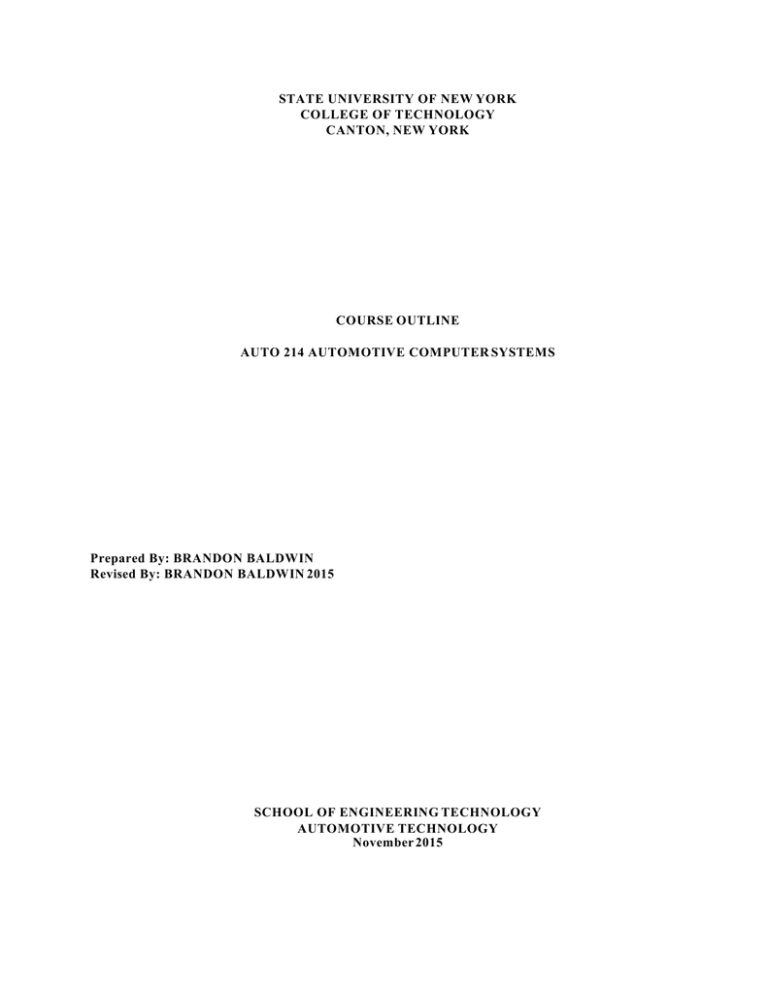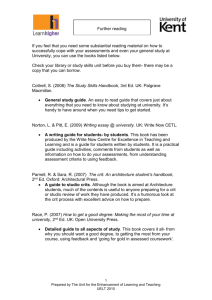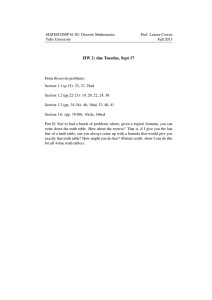AUTO 214 Automotive Computer Systems
advertisement

STATE UNIVERSITY OF NEW YORK COLLEGE OF TECHNOLOGY CANTON, NEW YORK COURSE OUTLINE AUTO 214 AUTOMOTIVE COMPUTER SYSTEMS Prepared By: BRANDON BALDWIN Revised By: BRANDON BALDWIN 2015 SCHOOL OF ENGINEERING TECHNOLOGY AUTOMOTIVE TECHNOLOGY November 2015 A. TITLE: AUTO 214 AUTOMOTIVE COMPUTER SYSTEMS B. COURSE NUMBER: AUTO 214 C. CREDIT HOURS: 3 D. WRITING INTENSIVE COURSE: No E. COURSE LENGTH: 15 WEEKS F. SEMESTER(S) OFFERED: SPRING G. HOURS OF LECTURE, LABORATORY, RECITATION, TUTORIAL, ACTIVITY: Two hours of lecture, two hours of laboratory per week H. CATALOGUE DESCRIPTION: Review of electrical and electronic devices used in automobiles. Study of on-board diagnostic systems for both domestic and import vehicles. Diagnosis of computerized automotive systems. I. PRE-REQUISITES/CO-REQUISITES: a. Pre-requisite(s): AUTO 212, AUTO 213, AUTO 220 b. Co-requisite(s): NONE J. GOALS (STUDENT LEARNING OUTCOMES): Course Objectives Design circuits using electronics. Describe the basic operation of an automotive computer Describe computer types and locations Access and interpret vehicle computer information using a scan tool Access and interpret vehicle computer information using a lab scope Perform diagnostics using scan tools and lab scopes Develop a systematic diagnostic process Perform all of the above within the safety guidelines in Auto 101, 111 and reviewed at the beginning of this course. Pass the Snap-On Diagnostic Exams. Construct a report of waveforms and be able to discuss the results. Pass the NATEF End of Program Exams with 90% or better Institutional SLO 2. Crit Thinking 3. Prof. Comp 3. Crit Thinking 3. Prof. Comp 2.Crit Thinking 3. Prof. Comp 2.Crit Thinking 3. Prof. Comp 2.Crit Thinking 3. Prof. Comp 2.Crit Thinking 3. Prof. Comp 2.Crit Thinking 3. Prof. Comp 2.Crit Thinking 3. Prof. Comp 2. Crit Thinking 3. Prof. Comp 1. Comm skills 2. Crit Thinking 3. Prof. Comp 2.Crit Thinking 3. Prof. Comp K. TEXTS: Diagnosis and Trouble Shooting of Automotive Electrical, Electronic, and Computer Systems by James Halderman. Electrical and Electronic Systems, NATEF Standards Job Sheets, 3rd edition. by Jack Erjavec. L. REFERENCES: Manufacturer Service manuals, Alldata, Snap-On Verus. M. EQUIPMENT: Classroom with overhead projector, scan tools, lab scopes, low amperage clamps N. GRADING METHOD: A-F, O. MEASUREMENT CRITERIA/METHODS: exams, quizzes, homework, lab performance, Snap-On exams success results in additional certificates P. DETAILED TOPICAL OUTLINE: I. Introduction 1. Tools 2. Safety II. ABS, Traction Control, and Electronic Stablility Control systems 1. Analyze and interpret wheel speed sensor data 2. Analyze and interpret EBCM data and operation principles III. Supplemental Inflatable Restraint Systems 1. Theory and operation 2. Handling IV. Motor analysis and interpretation used for diagnosis 1. fuel pumps 2. ABS pumps 3. window motors V. Solenoid analysis and interpretation use for diagnosis 1. starter 2. fuel injectors 3. EGR VI. Computer communication progression 1. ODB I 2. OBD II 3. CAN/BUS 4. 10 modes of OBD II in CAN VII. Snap-On Diagnostics Training using the Snap-On Verus 1. Navagation 2. Electrification and Measurement VIII. Hybrids 1. Introduction 2. Safety 3. Regenerative Braking 4. Fuel Cells Q. LABORATORY OUTLINE: I. Introduction 1. Tools 2. Safety II. Review scan tool operations 1. Data retrieval and interpretation 2. Reading diagnostic trouble codes 3. Using diagnostic trouble codes to diagnose concerns with diagnostic charts 4. Repair concern associated with diagnostic trouble codes 5. Diagnosis using snapshot and freeze frame functions III. Lab scope operations 1. Actuator data retrieval and interpretation 2. Diagnosis using live signal viewing and waveforms 3. Use low amperage clamps to retrieve waveforms IV. Scan tool diagnostics using CAN/BUS 1. Observe and practice methods used with scan tools and DVOM that now can be done with one tool. 2. Observe and practice computer network communications V. Use the 10 Modes of OBD II to diagnose Engine Performance issues. VI. Hybrids 1. Safety 2. Scan Tool usage for diagnosis

